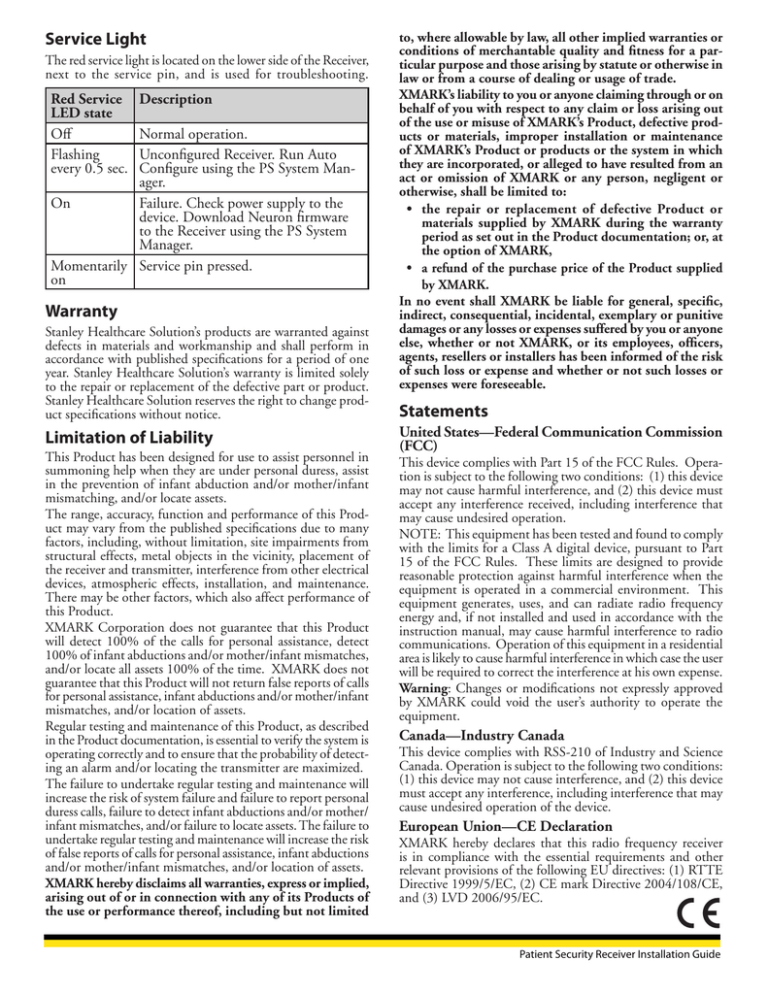
Service Light
The red service light is located on the lower side of the Receiver,
next to the service pin, and is used for troubleshooting.
Red Service
LED state
Off
Flashing
every 0.5 sec.
Description
Normal operation.
Unconfigured Receiver. Run Auto
Configure using the PS System Manager.
On
Failure. Check power supply to the
device. Download Neuron firmware
to the Receiver using the PS System
Manager.
Momentarily Service pin pressed.
on
Warranty
Stanley Healthcare Solution’s products are warranted against
defects in materials and workmanship and shall perform in
accordance with published specifications for a period of one
year. Stanley Healthcare Solution’s warranty is limited solely
to the repair or replacement of the defective part or product.
Stanley Healthcare Solution reserves the right to change product specifications without notice.
Limitation of Liability
This Product has been designed for use to assist personnel in
summoning help when they are under personal duress, assist
in the prevention of infant abduction and/or mother/infant
mismatching, and/or locate assets.
The range, accuracy, function and performance of this Product may vary from the published specifications due to many
factors, including, without limitation, site impairments from
structural effects, metal objects in the vicinity, placement of
the receiver and transmitter, interference from other electrical
devices, atmospheric effects, installation, and maintenance.
There may be other factors, which also affect performance of
this Product.
XMARK Corporation does not guarantee that this Product
will detect 100% of the calls for personal assistance, detect
100% of infant abductions and/or mother/infant mismatches,
and/or locate all assets 100% of the time. XMARK does not
guarantee that this Product will not return false reports of calls
for personal assistance, infant abductions and/or mother/infant
mismatches, and/or location of assets.
Regular testing and maintenance of this Product, as described
in the Product documentation, is essential to verify the system is
operating correctly and to ensure that the probability of detecting an alarm and/or locating the transmitter are maximized.
The failure to undertake regular testing and maintenance will
increase the risk of system failure and failure to report personal
duress calls, failure to detect infant abductions and/or mother/
infant mismatches, and/or failure to locate assets. The failure to
undertake regular testing and maintenance will increase the risk
of false reports of calls for personal assistance, infant abductions
and/or mother/infant mismatches, and/or location of assets.
XMARK hereby disclaims all warranties, express or implied,
arising out of or in connection with any of its Products of
the use or performance thereof, including but not limited
to, where allowable by law, all other implied warranties or
conditions of merchantable quality and fitness for a particular purpose and those arising by statute or otherwise in
law or from a course of dealing or usage of trade.
XMARK’s liability to you or anyone claiming through or on
behalf of you with respect to any claim or loss arising out
of the use or misuse of XMARK’s Product, defective products or materials, improper installation or maintenance
of XMARK’s Product or products or the system in which
they are incorporated, or alleged to have resulted from an
act or omission of XMARK or any person, negligent or
otherwise, shall be limited to:
• the repair or replacement of defective Product or
materials supplied by XMARK during the warranty
period as set out in the Product documentation; or, at
the option of XMARK,
• a refund of the purchase price of the Product supplied
by XMARK.
In no event shall XMARK be liable for general, specific,
indirect, consequential, incidental, exemplary or punitive
damages or any losses or expenses suffered by you or anyone
else, whether or not XMARK, or its employees, officers,
agents, resellers or installers has been informed of the risk
of such loss or expense and whether or not such losses or
expenses were foreseeable.
Statements
United States—Federal Communication Commission
(FCC)
This device complies with Part 15 of the FCC Rules. Operation is subject to the following two conditions: (1) this device
may not cause harmful interference, and (2) this device must
accept any interference received, including interference that
may cause undesired operation.
NOTE: This equipment has been tested and found to comply
with the limits for a Class A digital device, pursuant to Part
15 of the FCC Rules. These limits are designed to provide
reasonable protection against harmful interference when the
equipment is operated in a commercial environment. This
equipment generates, uses, and can radiate radio frequency
energy and, if not installed and used in accordance with the
instruction manual, may cause harmful interference to radio
communications. Operation of this equipment in a residential
area is likely to cause harmful interference in which case the user
will be required to correct the interference at his own expense.
Warning: Changes or modifications not expressly approved
by XMARK could void the user’s authority to operate the
equipment.
Canada—Industry Canada
This device complies with RSS-210 of Industry and Science
Canada. Operation is subject to the following two conditions:
(1) this device may not cause interference, and (2) this device
must accept any interference, including interference that may
cause undesired operation of the device.
European Union—CE Declaration
XMARK hereby declares that this radio frequency receiver
is in compliance with the essential requirements and other
relevant provisions of the following EU directives: (1) RTTE
Directive 1999/5/EC, (2) CE mark Directive 2004/108/CE,
and (3) LVD 2006/95/EC.
Patient Security Receiver Installation Guide
Patient Security Receiver Installation Guide
Part Number: 816A1001
Important!
Have you:
• Pulled network and power cable?
• Resolved power supply requirements?
• Selected the location for the PS Receiver?
Read these instructions thoroughly before
installing the PS Receiver. Faulty installation
can lead to system failure.
Materials Required
• International Patient Security Receiver (p/n 816A1001)
• Facility floor plan indicating Receiver position and network wiring path
• 105 Ω network terminator (p/n 805A2401) - if this is the
last device on the network segment
Specifications
Frequency
Supply Voltage
Current Draw
434.17 MHz
12-30 VDC
150 mA max. @ 12 V, 80 mA max. @
24V
Detection
35 ft. (11 m) for typical Receiver setup
Radius
50 ft (15 m) Receiver in open space
Communications LonWorks two wire
Ethernet port - currently not being
used.
Temperature
Operating: 32°F to 120°F (0°C to
49°C)
Storage: -22° to 158° F (-30° to 70°C)
Humidity
0-85% RH @ 70°F (21°C), non-condensing
Dimensions
Approximately 6.1 x 4.9 x 1.7 in. (155
x 125 x 45 mm)
Weight
Approximately 8.5 oz. (240 g)
Recommended Receiver Antenna
Orientation
For best coverage, ensure that the antennas are at
least 3 ft. (91 cm) from metal objects, such as framing or air ducts. Do not encase, wrap, or otherwise
cover the antennas.
One antenna must be pointing downward with the
second antenna aimed horizontally into a clear area,
free of metal objects. The two antennas must be at
right angles to one another.
Use the illustrations below as a guideline for antenna
orientation.
309 Legget Drive Ottawa, ON K2K 3A3 Canada
Telephone: 1.866.559.6275 International: +1 (613) 592.6997 Facsimile: (613) 592.4296
Web site: www.stanleyhealthcare.com
© 2010 XMARK Corporation. All Rights Reserved.
Printed in Canada. January 2010. 981-806009-000 Rev 01.
Certified to the ISO 9001 Quality Standard
Installation Considerations
• Position the Receiver beneath ceiling obstructions—
When installing above drop ceilings, mount the
Receiver below metal duct work and pipes
• If ceiling tiles are foil-backed, mount Receiver below.
• Route cables up and away from the Receiver—When
the cable is not in conduit, route it directly away from
the Receiver for at least 1 foot (30 cm).
• Install the Receiver temporarily until testing is complete—Fastenings should be secure enough that the
Receiver can be permanently mounted without disturbing its orientation.
• Point the horizontal antenna into a clear area, away
from metal objects—One antenna always points
downwards, with the second antenna (horizontal) at
a 90 degree angle (can be adjusted to suit site conditions). Make sure the horizontal antenna is not running parallel to cabling in the ceiling.
• Observe temperature and humidity restrictions—
Refer to the Specifications table.
• Leave slack in the cable—Leave at least 10 ft. (3 m)
of slack in the communication and power cables to
allow for adjustments in the location of the Receiver.
• No user adjustments to internal circuitry—Tampering
may cause component or system failure, or both, and
will void the warranty.
Installing the Patient Security Receiver
• Ensure that the power supply and network are turned off to prevent electrical
shock or damage to equipment.
• Touch your hand to ground to discharge
any electrostatic charge before handling
the Receiver.
4 Install the Mounting Plate. Referring to the facility floor
plan, decide the position of the Receiver. Do not place
near metal objects and structural frames. Ensure that the
service light will be visible and that space is allowed for
the antennas. Install the mounting plate using one of
the following methods.
A Fasten to a suspended ceiling guy wire, using:
• 1 multi-function Caddy clip
• 2 machine screws
• 2 hex nuts
• 2 lock washers, OR
B Install directly to a ceiling or a wall using:
• 2 wood screws
• 2 hollow wall anchors, OR
Install to a receptacle box, using:
• 2 machine screws
5 Install the Receiver to the Mounting Plate.
Plug the wired terminal block into the Receiver and
install the Receiver onto the Mounting Plate, using the
screws removed in Step 2. DO NOT place excess network and power supply wires inside the Receiver case.
6 Attach the two clips to lock the antennas in place.
Do not supply power to the Receiver or any
other network device until all connections
are complete.
Final Steps
Once all devices are installed,
power up the Receiver and
other devices. Using the PS
System Manager, run Auto Configure to install the new
devices, and then configure them for operation.
The coverage area of the Receiver must also be checked.
The steps below correspond to the numbers in Figure 1. Status Light
1 Record the LonWorks Neuron ID number.
The green status light is located on the front of the
Locate and record the LonWorks Neuron ID number Receiver, and indicates the current status of the Receiver.
onto the facility floor plan indicating the Receiver’s Green Status LED Description
position and network wiring path. Affix one of the state
supplied Neuron ID labels on the floor plan and affix Off
No tags within range or no power.
the other on the Receiver in a visible location.
Flashing
The Receiver is receiving tag
2 Remove the Mounting Plate from the Receiver by coincident with transmissions.
sliding it off. If the Receiver is to be installed to a tag transmissions
receptacle box, pass the network and power supply Flashing steady
Wink command currently
wires through the hole in the Mounting Plate.
for two seconds, operating.
off for one
NOTE: Intermittent flashes
3 Wire the terminal block.
second repeatedly between the steady two second flash
Connect the LonWorks Network IN, Network
indicates the presence of tags within
OUT, and Power Supply to the terminals. If the
the area.
Receiver is at the end of the network segment,
Failure. Check power connecOn
then terminate the network segment with a 105 Ω
tions or download firmware to
the Receiver using the PS System
terminator.
Manager.
Patient Security Receiver Installation Guide
If the Receiver is not at
the end of the network segment,
connect the wires as shown below.
If the Receiver is at the end of the
network segment,
use a terminator as shown below.
! Labelled "OUT"
! Labelled "OUT"
DO NOT CONNECT
DO NOT CONNECT
ITEM A
105 terminator
(at each end
of network)
NETWORK NEG- POS+
IN
POWER
(non-polarized)
NETWORK NETWORK NEG- POS+
OUT
IN
POWER
(non-polarized) (non-polarized)
For ceiling mounts, fasten to
a suspended ceiling
guy wire using a caddy clip.
4B
Place one Neuron ID label on
the Receiver in a visible location.
6
Figure 1: Physical Connections for the Receiver
Patient Security Receiver Installation Guide





